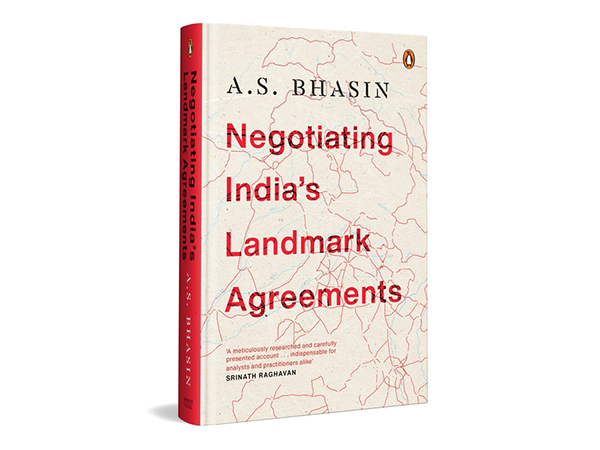By A R Ghanashyam
New Delhi [India], November 16 (ANI): In his recent Book “Negotiating India’s Landmark Agreements” author AS Bhasin identifies five seminal Indian bilateral agreements viz., (i) India-China Agreement on Tibet (1954), (ii) Indo-Soviet Treaty of Peace, Friendship and Cooperation (1971), (iii) Th Shimla Agreement (1972), (iv) India – Sri Lanka Accord (1987) and (V) India-United States Civil Nuclear Energy Agreement (2008) for scrutiny.
He analyses the conceptualization and formalization of the agreements peppered with riveting stories of real politic that influenced the contours of interactions during meetings at official and political levels meticulously drawing on authentic archival sources.
The Agreement on Tibet concluded in 1954 was the earliest negotiated by and between India – then a seven-year-old sovereign nation and China five-year-old. During the British raj and post-independence, India had close linkages with Tibet.
It managed the Post and Telecommunications of Tibet, had trade centres in major cities, a security escort for its officials and even its own doctors and hospitals. Before 1950, Tibetan leaders did seek to consolidate their sovereignty with help from India and the United States but in vain.
Once China occupied Tibet in 1950 and the Tibetan delegation signed the 17 points agreement in Beijing, even if it was under duress, Tibet had no choice but to become a part of China.
With the conclusion of the Tibet Agreement, India lost everything it had, and Chinese not only managed to consolidate their hold on Tibet but also evacuated Indians from Tibet once and for all. The author laments that while negotiating this Agreement Prime Minister Jawaharlal Nehru was more concerned about retaining the goodwill of the negotiating partner than protecting India’s own interests.
On the Indo-Soviet Treaty, the author has some interesting inferences. The Soviet Union floated a proposal for an “Asian Collective Security” in 1969 to bring the Asian Nations in a voluntary collective against China. Not to deviate from its hitherto well-known policy of non-alignment, India stonewalled USSR’s offer of a Treaty and insisted on a formal statement by USSR that it would flank India if the latter were attacked by another country.
But the Soviet leadership was worried that if such a statement were issued India would lose interest in the Treaty. As recently as on June 5, 1971, when Indian Envoy to USSR Durga Prasad Dhar made his farewell call on Soviet Defence Minister Marshal Grechko the latter told him that India should be worried about China to the north and not Pakistan.
He informed Dhar in that meeting that the Chinese had laid claim to 1.5 million square kilometres of Soviet land with 8 million inhabitants. The Chinese troops quietly retreated after seeing the massive mobilization of vastly superior Soviet military force at the border.
The author argues that the Soviet offer to India of a Friendship Treaty was neither unselfish and nor philanthropic but had a purpose. It wanted to involve India in its ideological and political dispute with China, taking advantage of India’s strained relations with Beijing after the 1962 War. And later, when India would not bite, soviets denied India vital weaponry to replenish Indian war losses (equipment and ammunition) of 1971.
The Simla Agreement was signed on July 2, 1972, by Prime Minister Indira Gandhi and President Zulfiqar Ali Bhutto. It involved the return of 93,000 Pakistani prisoners of war and areas of west Pakistan occupied by India during the war.
The narrative addresses reports of a so-called secret agreement on Kashmir between Indira Gandhi and Bhutto but notes that had there been one there are no documents to substantiate it. The author points out that Pakistan had conveyed to Soviet leaders who in turn informed Indira Gandhi that Bhutto was willing to discuss Kashmir, but later.
There is mention of a one-to-one meeting between Prime Minister Indira Gandhi and President Bhutto for which they both took a break after the main course of the dinner on July 2. PN Haksar, Principal Secretary to PM and PN Dhar, Secretary to PM were both briefed about that meeting by Gandhi. But neither recorded it; at least no record of it has been found.
A plausible interpretation of what may have happened in that meeting can be drawn from a letter dated August 7, 1972, which Indira Gandhi wrote to Sri Lankan Prime Minister Bandaranaike, “On the Indian side, we felt that durable peace was not possible without a settlement of the Kashmir question. The President assured me that he would like to do this and seemed to accept that he himself called a “line of peace” on the border. However, he did not wish to make it public at present.”
The author notes that after the Simla Agreement was signed and Pakistan prisoners reached home, Pakistan returned to its old ways of antagonism. The old issues which should have been settled, remained unresolved and the past narrative came back quickly. India could only take solace in the fact that it had helped split the partitioned Pakistan. Simla Agreement was one other missed opportunity for India.
On the India Sri Lanka Accord the author says that to begin with the Tamil problem was an internal problem of Sri Lanka between minority Tamils who accounted for barely 13% of the population and the Sinhala speaking citizens who comprised 84%. Secondly, and intriguingly, government of the Indian state of Tamil Nadu got involved in providing financial and strategic support to the Tamils and their militant wing – Liberation Tigers of Tamil Eelam (LTTE) making the task of dealing with Sri Lanka more complex for the Centre in Delhi.
The LTTE began with a demand for autonomy almost bordering on independence for the northern and eastern provinces that had majority Tamil population. They foolishly hoped that India would do a repeat of Bangladesh for them in Sri Lanka.
The LTTE later went berserk with brutal killings of Sri Lankan officials and Security forces. Towards the end it even turned against the IPKF (Indian Peace Keeping Force) sent to dissuade them to disarm themselves and work with the government of Sri Lanka for an amicable settlement under the Sri Lanka Accord.
Tables turned for IPKF when LTTE alleged human rights violations by IPKF and announced direct negotiations with Colombo. Finally, government of Sri Lanka launched a blitzkrieg against LTTE and killed its charismatic leader Velupillai Prabhakaran.
The author underlines some crucial facts of the Sri Lanka Accord. First, President Jayawardane signed the Accord against the advice of his Prime Minister and most of his cabinet ministers. Prime Minister Rajiv Gandhi ignored the prudent advice of his cabinet colleague Narasimha Rao and entered where angels fear to tread.
The author concludes that Rajiv Gandhi’s adventurous policy met with the greatest foreign policy disaster for India since 1962. Ultimately Rajiv Gandhi himself paid a heavy price of his own life to a Tamil militant.
The last Agreement the author looks at is India-US Civil Nuclear Energy Agreement of 2008. After three years of intense bilateral negotiations an amendment to the US Atomic Energy Act of 1954 was approved. India separated its 35 civilian nuclear Plants from military counterparts and agreed to open the civilian Plants for IAEA (International Atomic Energy Agency) inspections.
The IAEA approved its safeguard agreement with India. Finally, the 48-member Nuclear Suppliers Club permitted India to access civilian nuclear technology and fuel from other countries. The US Congress and Senate approved the Agreement with a majority of 298/117 and 86/13 respectively confirming bipartisan support for the Agreement. It was narrower in the case of India where Lok Sabha approved the Agreement with 275 votes for and 256 against.
In his narrative on the India-US Agreement the author gives a major share of the credit to US Secretary of State Condoleezza Rice who kept a hawk’s eye on the deliberations and swiftly moved in to resolve issues each time a hurdle was faced by either side and she had the full support of President George W Bush. Manmohan Singh too gets unqualified appreciation for his dexterous navigation in building a consensus in the coalition government.
The enactment by India of its Civil Liability Act adopted in 2010 made suppliers of nuclear plant and equipment and material instead of operators potentially liable for compensation in the event of a nuclear disaster – a more stringent condition compared to prevailing international standards.
This is by far the most serious hurdle which prevented the harnessing of nuclear energy cooperation between India and United States. Domestic opposition in India, high cost of nuclear plants, the diffidence after the Fukuyama disaster in Japan and attractive renewable energy options like solar power also played their parts.
For a quarter of a century since independence India religiously followed Former PM Nehru’s non-alignment as the backbone of its foreign policy. In 1971 that tenet of Indian foreign policy came to be compromised when circumstances forced India to agree to a Treaty with the Soviet Union. The India-US Civil Nuclear Energy Agreement of 2008 was the second seminal deviation from non-alignment in national interest by India.
The narrative on how each Agreement went through the rigorous process of discussion and debate is a gripping saga skillfully told by the author with the help of documents and records of discussions at various levels between some of the most eminent and legendary Indian and Foreign interlocutors.
It makes the book a fascinating read not just for mandarins of foreign policy and students of political science but also to lay readers from all walks of life who want to understand and appreciate the history and nuances of some of India’s crucial bilateral Agreements. I enjoyed the eminently readable book, and I strongly recommend it.
AR Ghanashyam is a retired Indian diplomat who has served as ambassador of India to Angola and High Commissioner of India to Nigeria. (ANI)
Disclaimer: This story is auto-generated from a syndicated feed of ANI; only the image & headline may have been reworked by News Services Division of World News Network Inc Ltd and Palghar News and Pune News and World News
HINDI, MARATHI, GUJARATI, TAMIL, TELUGU, BENGALI, KANNADA, ORIYA, PUNJABI, URDU, MALAYALAM
For more details and packages











